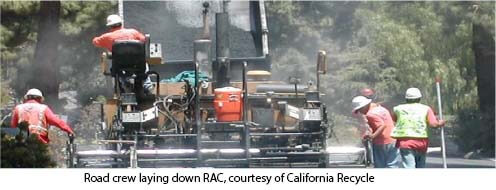In Search Of Quieter Roads
While driving down the highway the other day I noticed new sound barrier walls being installed. It's hard to argue against the idea of lowering road noise but these large walls seem very expensive. And they don't seem to lower the road noise in the cabin of my car. So, as I'm driving along I begin to wonder if there's a better way to reduce this noise. Low and behold, I do a little research and the term "Rubberized Asphalt Concrete" (RAC) shows up prominently.
RAC sounds like an eclectic collection from a junkyard that couldn't possibly be of any value. However, it was intriguing enough to research further and what I found out was something that could have a positive impact on driving. In 2003 a pilot program to test the sound qualities of RAC was performed in Phoenix by the Arizona Department Of Transportation in conjunction with the Federal Highway Administration. The key ingredient in both rubberized asphalt and rubberized asphalt concrete is the addition of ground rubber.

The good news is that used tires, which have always gone directly to landfill, are ground-up and become part of the road. As it turns out, many states including Arizona and California, have been utilizing RAC for a while now with good results. It is fairly durable, has great sound reduction qualities, and is great for the environment as it consumes a large number of used tires in the process.
Although RAC has been in use for many years in various road projects, only recently have studies been performed on its sound qualities. These studies have shown up to a 10 decibel reduction in road noise - that translates into a 90% noise reduction. As a comparison, sound barriers typically reduce road noise by 5-7 decibels for houses directly along the highway and have no impact on noise within cars.
In addition to its noise reduction qualities, RAC has several other advantages such as requiring as much as 50% less material to pave a road that lasts up to 50% longer. The environmental impact is equally as great for consuming scrap tires as a 2 inch thick pavement uses 2,000 scrap tires per lane mile. That's a lot of scrap tires put to use that would normally wind up in landfills. And lastly, the crumbled tires replace some of the oil in the RAC compound reducing the need for oil in our paving projects.
RAC reduces noise, is less expensive, and less costly to maintain so what's the catch? Well as it turns out RAC has only been used in warm climates and is typically laid down when the outside temperatures exceed 85 degrees. That's why most of the information has been from studies in Arizona and California. However, newer formulations have lead to testing in northern climates, including Massachusetts and Washington state. So far the results are looking positive which may lead to the rapid use of RAC in many new areas.
There is a foundation for noise reducing pavements which has further information on the topic. This appears to be one of those rare win-win scenarios for the environment and we should encourage our elected officials to pursue this technology as quickly as possible.
